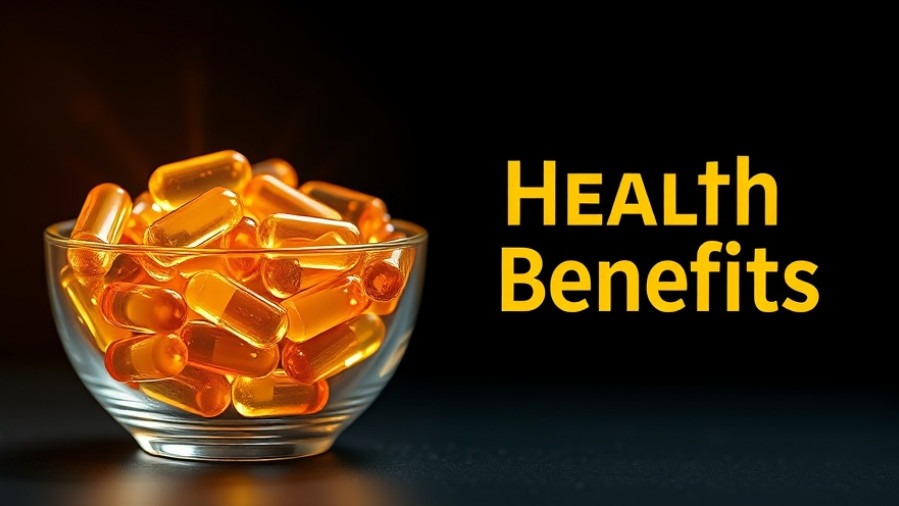
The Essential Vitamin for Senior Health
As we age, maintaining good health becomes a top priority. For those over 60, understanding the importance of blood circulation is vital to reducing serious health risks like strokes or clots. A recent discussion reveals that there is an essential vitamin—Vitamin B3—that can enhance blood circulation and significantly aid in the prevention and management of blood clots. But this doesn't just stop at Vitamin B3. In this article, we’ll explore other crucial vitamins, such as Vitamin C, K, and E, which all play an integral role in promoting a healthy circulatory system.
In 'Over 60? This Vitamin MELTS Blood Clots and Boosts Circulation Naturally,' we delve into crucial vitamins that can significantly improve blood circulation and prevent dangerous health issues. This prompted us to explore their extensive benefits further.
Your Body's Signals: Why Pay Attention?
When it comes to health, our bodies often send us signals, and recognizing these signs can be a game-changer. Changes in skin color on your legs, painful cramps while walking, or even cold feet can indicate poor circulation. These symptoms, while seemingly innocuous at first, can lead to serious complications if ignored.
Many seniors believe sweating it out with light exercise is enough for blood flow, but it’s vital to recognize that aging bodies may be deficient in key nutrients. Ignoring symptoms, like those painful cramps or tingling sensations, could mean more than just inconvenient discomfort; they can be loud proclamations to be more proactive about your health.
The Miracle of Vitamin B3: The Heart’s Best Friend
Vitamin B3, commonly known as niacin, is more than just another nutrient—it's a hero in the fight against poor circulation. It aids in expanding blood vessels, improving blood flow, and lowering bad cholesterol levels. Integrating Vitamin B3 into your diet through food sources like chicken, tuna, and almonds can bring significant benefits. However, be aware of the 'niacin flush,' a common side effect characterized by warm, reddened skin, especially in the face. To avoid discomfort, consider sourcing your vitamin from natural food sources instead of supplements.
The Power of Vitamin C: A Shield for Your Blood Vessels
Vitamin C isn't just for warding off colds; it plays a protective role for blood vessels. It's crucial for boosting collagen production, which is essential for keeping our blood vessels strong and flexible. Incorporating foods rich in vitamin C—like oranges, strawberries, and bell peppers—can bolster your circulation effectively. Remember, fresh is best; consider consuming these fruits raw or minimally cooked to maximize their benefits.
Vitamin K: The Unsung Hero of Flexibility
While vitamins B3 and C get a lot of attention, Vitamin K deserves its time to shine. This vitamin helps keep your arteries flexible by preventing calcium deposits from hardening. Incorporate green leafy vegetables like spinach and kale into your meals to enjoy the full spectrum of benefits from Vitamin K, ensuring your arteries stay properly functioning.
Vitamin E: The Antioxidant Champion
Last but by no means least, Vitamin E is your vascular health ally. With its antioxidant properties, Vitamin E protects blood vessels and promotes the relaxation of blood vessels through nitric oxide production. You can find abundant Vitamin E in sources like almonds, sunflower seeds, and olive oil. Pairing these foods with others can create a delicious and healthy meal that supports circulation.
Take Action: Your Health is In Your Hands
Recognizing the importance of maintaining health, particularly for those over 60, is paramount. With optimal blood circulation, you can alleviate discomfort and reduce risks associated with aging. The essential vitamins discussed—B3, C, K, and E—offer an integrated approach to improving your circulatory health. Investing in your nutrition now promises long-term benefits for your heart and overall well-being.
Don't wait for symptoms to escalate. Embrace these vital nutrients as part of your daily routine, and help secure a healthier future. By making informed dietary choices, you empower yourself to combat the effects of aging healthily.
 Add Row
Add Row  Add
Add 




Write A Comment